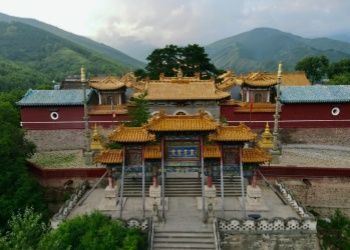Mount Wutai is composed of five towering peaks, standing high and straight into the clouds, resembling five enormous pillars supporting the heavens and the earth. Among the peaks, clouds and mist swirl, resembling a fairyland. Standing atop Mount Wutai, one can overlook the surrounding mountains, which stretch endlessly, their peaks overlapping, presenting a magnificent view.
Within the scenic area, temples abound, the most famous being the Pusading Temple, located on the summit of Zhongtai Mountain. This temple's architecture is majestic and resplendent, exuding a sense of solemnity and dignity. The Buddha statues inside the temple are lifelike, and the murals are colorful, making one feel as if they have entered the sacred halls of Buddhism. In addition, there are many other temples such as Xiantong Temple, Tayuan Temple, and Shuxiang Temple, each with its unique architectural style and profound cultural connotation.Visiting the scenic area of Mount Wutai allows one to not only appreciate the extensive and profound Buddhist culture but also feel the magical charm of nature. Whether wandering along the quiet paths between the temples or climbing the precipitous peaks, one can feel refreshed and delighted, reluctant to leave.
Must See Attractions
Tayuan Temple
 The Tayuan Temple
The Tayuan Temple
Mount Wutai Tayuan Temple is located in Taihuai Town, the Buddhist center of Mount Wutai in Shanxi Province. It was the pagoda courtyard of the Dahuayan Temple. It was expanded and renamed in the fifth year of the Yongle reign of Emperor Chengzu of the Ming Dynasty (1407), becoming one of the five major Zen temples and one of the ten monasteries in Qingmiao. The temple was designated as a national Buddhist temple in Han areas by the State Council in 1983 and was listed as a national cultural relic protection unit in 2007. The temple faces south, composed of horizontally arranged hall courtyards, meditation halls, and monastic quarters. The buildings on the central axis include a screen wall, a memorial archway, stone steps, a gateway, a main gate, bell and drum towers, a Hall of the Heavenly Kings, a Hall of Great Mercy and Longevity, a Pagoda Hall and Sutra Pavilion, as well as Shanhai Tower and Wenshu Temple Pagoda. With over 130 halls, chambers, and buildings, it covers an area of 15,000 square meters, exhibiting a majestic atmosphere. In front of the temple stands a three-room wooden memorial archway, delicate and elegant, built during the Wanli period of the Ming Dynasty. The main buildings within the temple are the Main Hall of Sakyamuni and the Sutra Pavilion, with the Stupa of Sarira located in the center. The temple is named for the Stupa of Sarira of Sakyamuni and the Stupa of Wenshu's Hair. The statues in each hall are well-preserved, and the wooden revolving sutra cabinet in the Sutra Pavilion has 20 layers, each layer filled with sutras for believers to worship and monks to recite.
Xiantong Temple
 The Xiantong Temple
The Xiantong Temple
Xiantong Temple was initially built during the Yongping reign of the Eastern Han Dynasty (69 AD) and was originally named Dafu Lingjiu Temple. It was expanded during the reign of Emperor Xiaowen of the Northern Wei Dynasty and rebuilt in the Tang Dynasty, when it was renamed "Dahuayan Temple". It was rebuilt again in the early Ming Dynasty, and Emperor Taizu granted it the name "Daxiantong Temple". The temple has a well-laid-out complex of halls, chambers, and buildings, with a clear central axis and symmetrical side temples. Pure wooden structures, masonry structures, and brass structures are the three main architectural features of Xiantong Temple. The main buildings include the Guanyin Hall, Wenshu Hall, Main Hall of Sakyamuni, Boundless Hall, Qianbo Hall, Bronze Hall, and Sutra Pavilion, totaling seven halls all along the central axis. Additionally, there are bell towers, monastic quarters, and various other side temples. The Bronze Hall is a particular highlight of Xiantong Temple. Cast in 1610 during the 38th year of the Wanli reign of the Ming Dynasty, it uses a total of 100,000 pounds of copper and is one of the best-preserved bronze halls in China. Moreover, Xiantong Temple treasures many precious cultural relics left over from history, such as the characters "dragon" and "tiger" inscribed on the stone tablets on both sides of the outer gate, which are relics from the Tang Dynasty and are extremely valuable.
Bodhisattva Summit
 The Bodhisattva Summit
The Bodhisattva Summit
Bodhisattva Summit is the largest Lama temple in Mount Wutai and has been designated as a national key Buddhist temple in Han areas by the State Council. The entire temple is resplendent in gold and colorful, exhibiting typical royal characteristics. Many emperors of past dynasties resided here when they came to worship at Mount Wutai, thus giving it an extremely high status. With a vast area and numerous halls and buildings, Bodhisattva Summit is the foremost temple of the Gelugpa sect in Mount Wutai. In front of the temple, there are 108 stone steps with a vertical height of 19.5 meters, a width of 5.1 meters, and a slope of 50 degrees. These steps are built with granite slabs and possess a majestic atmosphere, resembling a "heavenly ladder," attracting many tourists to take photos here.
Nanchan Temple
 The Nanchan Temple
The Nanchan Temple
Nanchan Temple boasts a history of over 1,200 years and is recognized as the earliest extant wooden structure in China, listed as a national cultural relic protection unit. Oriented towards the south, the temple covers an area of approximately 3,078 square meters. Although not large in scale, its layout is reasonable, and its structure is compact. The main hall is the core building of Nanchan Temple and the oldest extant wooden structure of the Tang Dynasty in China. The exterior of the hall is beautiful, with a graceful and ancient appearance. The beam frame inside the hall is concise, with the walls serving only as partitions and not bearing any weight. The roof weight is primarily supported by the beam frame and columns on the eaves walls. This structural form not only reflects the characteristics of Tang Dynasty architecture but also ensures the stability and aesthetics of the building. The flat beam inside the hall is supported by two fork braces without the use of short columns, maintaining the inherent architectural characteristics of the Han and Tang Dynasties with a concise design. Additionally, there is a uniquely shaped and intricately carved stone pagoda from the Tang Dynasty inside the hall, providing significant physical evidence for studying Tang architecture and stone carving art.
Foguang Temple
 The Foguang Temple
The Foguang Temple
This temple was initially constructed during the reign of Emperor Xiaowen of the Northern Wei Dynasty (471-499), boasting a long history. It underwent a significant reconstruction in the 11th year of Emperor Dazhong's reign in the Tang Dynasty (857), resulting in a unique architectural style that integrates features from multiple eras, ranging from the Northern Wei to the Tang, Song, Jin, Yuan, Ming, and Qing dynasties. The comprehensiveness of its chronological span is unparalleled among ancient Chinese buildings. Inside the temple, there are 35 Tang Dynasty painted sculptures, accounting for nearly half of the over 80 Tang Dynasty painted sculptures in the country, as well as precious Tang Dynasty mural paintings, fully demonstrating the charm of Tang art. Not only is Fo Guang Temple architecturally magnificent, but it also possesses high cultural value. The cultural relics within the temple span multiple dynasties, including stone stelae, Tang-era pagodas, and the Patriarch Pagoda, all of which are the essence of Tang Dynasty Buddhist art in China. In 1937, renowned architectural scholars such as Liang Sicheng conducted an investigation and surveying of Fo Guang Temple, bringing its value to wider recognition. Nowadays, Fo Guang Temple has been listed as a national cultural relic protection unit and is renowned as the "First Ancient Building in Asia" and "Buddha's Light in Asia" due to its exceptional historical, artistic, and scientific values.
Nanshan Temple
 The Nanshan Temple
The Nanshan Temple
The architectural features of Nanshan Temple are not only reflected in its layout and craftsmanship but also in its sonic culture. As a royal temple of the Yuan Dynasty, Nanshan Temple serves as an important training ground for the "Buddhist sonic rituals" of Mount Wutai. The uniqueness of its ritual sounds and the inheritance and development of the "shengguan di" offering music have become typical representatives of Han Chinese Buddhism's sonic rituals on Mount Wutai, adding a unique color to the Buddhist culture of the mountain. In addition, the carving art of Nanshan Temple is also the best among all temples on Mount Wutai, and the 18 Arhats sculpted there are the finest among Arhat sculptures. These Arhat figures are vivid and lifelike, demonstrating the superb skills and profound cultural heritage of ancient artists. Meanwhile, there are also 84 painted Buddhist legends within the temple, with vivid images and bright colors, exhibiting great artistic value.
Best Time to Travel
Summer is the best season to visit Mount Wutai:
Mount Wutai's climatic characteristics make summer the most suitable time for tourism. Located at a relatively high altitude, the average annual temperature of Mount Wutai is relatively low. Even in summer, the average temperature remains within a comfortable range. Compared to the outside of the mountain, the temperature in Mount Wutai is about 10℃ lower in summer, making it an ideal summer resort. Especially for tourists from hotter regions, the climatic conditions here are very pleasant. The lush greenery and blooming flowers and plants of Mount Wutai provide a wonderful venue for tourists to appreciate the beauty of nature. In addition, summer is also a good time to observe sea of clouds. Standing at the high point of Mount Wutai, visitors can overlook the spectacular roiling sea of clouds, feeling the grandeur and mystery of nature.
Travel Information
Opening Hours:
Open all day, all year round
Ticket Prices:
Peak season (April 1st - October 31st): 135 yuan
Off season (November 1st - March 31st): 118 yuan
Travel Tips
· Summer is the best time to visit Mount Wutai, but it also attracts a large number of tourists. Winter, on the other hand, offers a more serene and unique experience. If you prefer a quieter atmosphere, visiting in winter might be the better choice.
· Some temples allow visitors to stay overnight and have meals, but these facilities are generally intended for Buddhist laypeople. If you choose to stay in a temple, please respect the temple rules and regulations.
· Accommodation options within the scenic area of Mount Wutai are limited, and the occupancy rate of guest rooms is extremely high. Additionally, water and power outages are common in the area. Therefore, it's advisable to make advance preparations. Finding accommodation during weekends and holidays can be particularly challenging. It's recommended to refrain from taking baths in Mount Wutai to prevent colds due to the large temperature differences between morning and evening in Shanxi.
· The temperature difference between morning and evening in Shanxi can be quite significant. Make sure to dress warmly and take note of the weather changes.




































